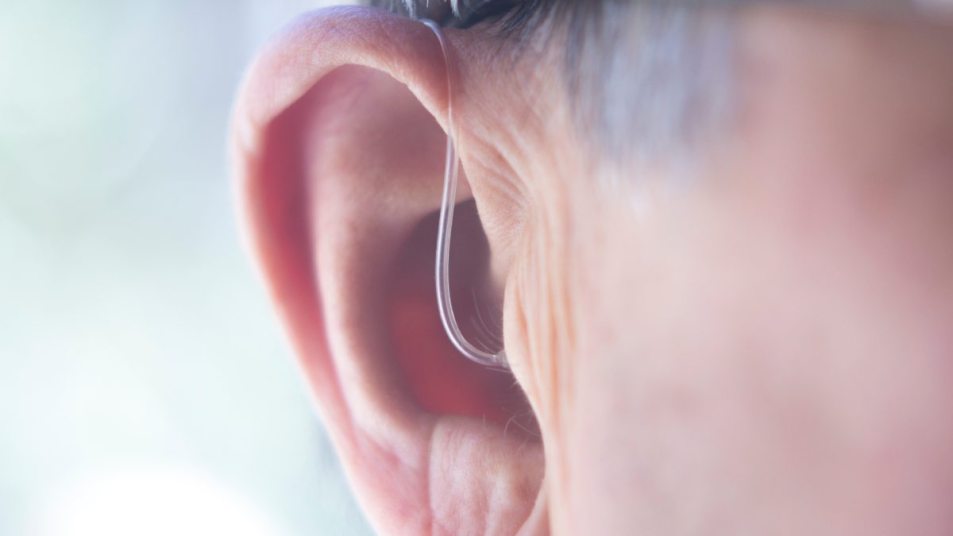FDA Says You Can Now Buy Hearing Aids Over the Counter — But Don’t Do It Just Yet
"OTC hearing aids" sold online are currently mismarked, and the real devices won't come until October.

Earlier this week, the Food and Drug Administration (FDA) ruled that hearing aids can be sold over the counter, no prescription needed. Consumers have long awaited this change; hearing exams are expensive and not often covered by health insurance. The new market competition will also push down the costs of hearing aids themselves.
For many Americans, this new rule is reason to celebrate. The US Census Bureau estimates that 11.5 million people in the US have some sort of hearing impairment, yet many Americans don’t use hearing aids. Left untreated, hearing loss impacts every aspect of life, including physical health, mental and emotional health, social skills, and self-esteem.
But it would be a mistake to immediately buy OTC hearing aids following this announcement. For one thing, they don’t exist yet, even though it seems like they do. And for another, prices have yet to come down. Here’s everything you need to know so you can make the most informed decision about your auditory health.
Right now, ‘OTC hearing aids’ sold online are improperly named.
Searching “OTC hearing aids” on Google will bring up a display of devices, all available for purchase without a prescription. Nearly all of them are marketed as hearing aids — but in the eyes of the FDA, they’re not.
“While certain devices advertise themselves as ‘hearing aids,’ the only devices that are currently sold online or in retail stores without a prescription are actually personal sound amplification products (PSAPs),” says Amy Sarow, AuD, clinical audiologist in Jacksonville, Florida. “These devices are less sophisticated than a hearing aid, in that they amplify all frequencies equally and do not distinguish between speech versus noise.”
Then what is a hearing aid? “A hearing aid is a medical device that is fit to an individual’s audiogram, or hearing prescription,” Dr. Sarow explains. “While a PSAP may provide some benefit for someone with a mild hearing loss, the sound quality of a hearing aid will be clearer and better. Additionally, a hearing aid is actually a tiny computer that constantly scans the environment to pick up speech, provide amplification to increase audibility, and reduce unwanted background noise.”
The FDA rule won’t go into effect until October.
According to the news release, the rule allowing OTC hearing aids doesn’t take effect until mid-October. As a result, we won’t see them in drug and retail stores for at least another month or two.
Some experts believe that mid-October is even too soon. “It will probably take longer (maybe until the end of the year) until the new OTC hearing aids are available in many stores,” says Philipp Orso, Head of audiology at Makehear Inc. “If possible, I would definitely wait until the new devices are available.”
The cost of hearing aids should go down significantly.
Currently, the average cost for a pair of hearing aids ranges between $2,000 and $7,000 — and basic Medicare doesn’t offer coverage. (A pair of PSAPs costs between $500 and $700, and they don’t work quite as well as hearing aids.) That doesn’t even account for the cost of audiology visits. Besides the first diagnostic exam, private insurers often don’t cover these appointments.
Dr. Sarow and Orso both believe that the availability of OTC hearing aids will help drive down costs and create other benefits. “As with many products on the market, competition can help to spur continued innovation while keeping prices fair,” says Dr. Sarow. “Hearing clinics will likely adapt as well, finding ways to incorporate and service patients who have purchased OTC devices but find themselves in need of more support.”
“I expect the costs for a pair of OTC hearing aids will range between $300 and $900,” adds Orso. “But that’s just my personal opinion.”
You may still need to visit an audiologist.
It might be tempting to buy your own hearing aids come October without visiting an audiologist or hearing aid specialist. However, getting an initial evaluation is still a good idea — Dr. Sarow points out that diagnostic exams are covered by Medicare and private insurers with a physician referral.
“Anyone contemplating hearing aids [should] have a hearing test, especially if they’ve never had one or not recently,” she adds. “Although a hearing test will technically not be required for OTC devices, [the devices] are unlikely to provide benefit if hearing loss is greater than a mild to moderate hearing loss.”
Finding the right hearing aids will still take some research.
If you still need to keep costs down after an initial evaluation, Dr. Sarow suggests doing your own research before making a purchase, preferably with the help of a friend or family member if you don’t feel tech savvy. There will be many options to choose from, including devices that go:
- behind the ear
- in the ear (but are very visible, like ear plugs)
- in the canal (visible but deeper in the ear)
- completely in the canal (invisible)
In-the-canal and completely-in-the-canal devices work only for mild to moderate hearing loss, so your choice will depend on your diagnosis. In addition, some devices are bluetooth compatible, meaning you can use them like headphones to play sounds from your electronic devices.
The bottom line? The FDA rule is a win for people with hearing loss, because it will help make hearing aids more accessible to everyone. Still, visiting an audiologist before buying will help you find the best product for your needs.












